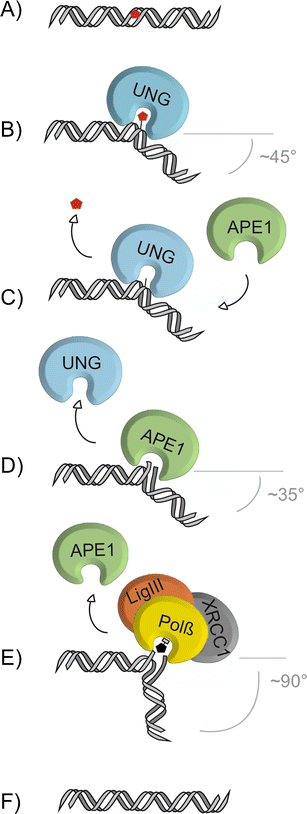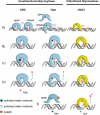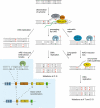DNA glycosylases: in DNA repair and beyond
- PMID: 22048164
- PMCID: PMC3260424
- DOI: 10.1007/s00412-011-0347-4
DNA glycosylases: in DNA repair and beyond
Abstract
The base excision repair machinery protects DNA in cells from the damaging effects of oxidation, alkylation, and deamination; it is specialized to fix single-base damage in the form of small chemical modifications. Base modifications can be mutagenic and/or cytotoxic, depending on how they interfere with the template function of the DNA during replication and transcription. DNA glycosylases play a key role in the elimination of such DNA lesions; they recognize and excise damaged bases, thereby initiating a repair process that restores the regular DNA structure with high accuracy. All glycosylases share a common mode of action for damage recognition; they flip bases out of the DNA helix into a selective active site pocket, the architecture of which permits a sensitive detection of even minor base irregularities. Within the past few years, it has become clear that nature has exploited this ability to read the chemical structure of DNA bases for purposes other than canonical DNA repair. DNA glycosylases have been brought into context with molecular processes relating to innate and adaptive immunity as well as to the control of DNA methylation and epigenetic stability. Here, we summarize the key structural and mechanistic features of DNA glycosylases with a special focus on the mammalian enzymes, and then review the evidence for the newly emerging biological functions beyond the protection of genome integrity.
Figures





Similar articles
-
Emerging Roles of DNA Glycosylases and the Base Excision Repair Pathway.Trends Biochem Sci. 2019 Sep;44(9):765-781. doi: 10.1016/j.tibs.2019.04.006. Epub 2019 May 9. Trends Biochem Sci. 2019. PMID: 31078398 Free PMC article. Review.
-
Automated AFM analysis of DNA bending reveals initial lesion sensing strategies of DNA glycosylases.Sci Rep. 2020 Sep 23;10(1):15484. doi: 10.1038/s41598-020-72102-7. Sci Rep. 2020. PMID: 32968112 Free PMC article.
-
Recognition of the oxidized lesions spiroiminodihydantoin and guanidinohydantoin in DNA by the mammalian base excision repair glycosylases NEIL1 and NEIL2.DNA Repair (Amst). 2005 Jan 2;4(1):41-50. doi: 10.1016/j.dnarep.2004.07.006. DNA Repair (Amst). 2005. PMID: 15533836
-
DNA repair in mammalian cells: Base excision repair: the long and short of it.Cell Mol Life Sci. 2009 Mar;66(6):981-93. doi: 10.1007/s00018-009-8736-z. Cell Mol Life Sci. 2009. PMID: 19153658 Free PMC article. Review.
-
[The role of glycosylases of the base excision DNA repair in pathogenesis of hereditary and infectious human diseases].Mol Biol (Mosk). 2008 Sep-Oct;42(5):891-903. Mol Biol (Mosk). 2008. PMID: 18988537 Review. Russian.
Cited by
-
NEIL1 and NEIL2 DNA glycosylases protect neural crest development against mitochondrial oxidative stress.Elife. 2019 Sep 30;8:e49044. doi: 10.7554/eLife.49044. Elife. 2019. PMID: 31566562 Free PMC article.
-
DNA Base Excision Repair in Plants: An Unfolding Story With Familiar and Novel Characters.Front Plant Sci. 2019 Aug 30;10:1055. doi: 10.3389/fpls.2019.01055. eCollection 2019. Front Plant Sci. 2019. PMID: 31543887 Free PMC article. Review.
-
The 2Ih and OXOG Proximity Consequences on Charge Transfer through ds-DNA: Theoretical Studies of Clustered DNA Damage.Molecules. 2023 Feb 26;28(5):2180. doi: 10.3390/molecules28052180. Molecules. 2023. PMID: 36903425 Free PMC article.
-
The Relevance of G-Quadruplexes for DNA Repair.Int J Mol Sci. 2021 Nov 22;22(22):12599. doi: 10.3390/ijms222212599. Int J Mol Sci. 2021. PMID: 34830478 Free PMC article. Review.
-
Base excision repair: a critical player in many games.DNA Repair (Amst). 2014 Jul;19:14-26. doi: 10.1016/j.dnarep.2014.03.030. Epub 2014 Apr 26. DNA Repair (Amst). 2014. PMID: 24780558 Free PMC article. Review.
References
Publication types
MeSH terms
Substances
LinkOut - more resources
Full Text Sources
Other Literature Sources
Molecular Biology Databases
Miscellaneous

